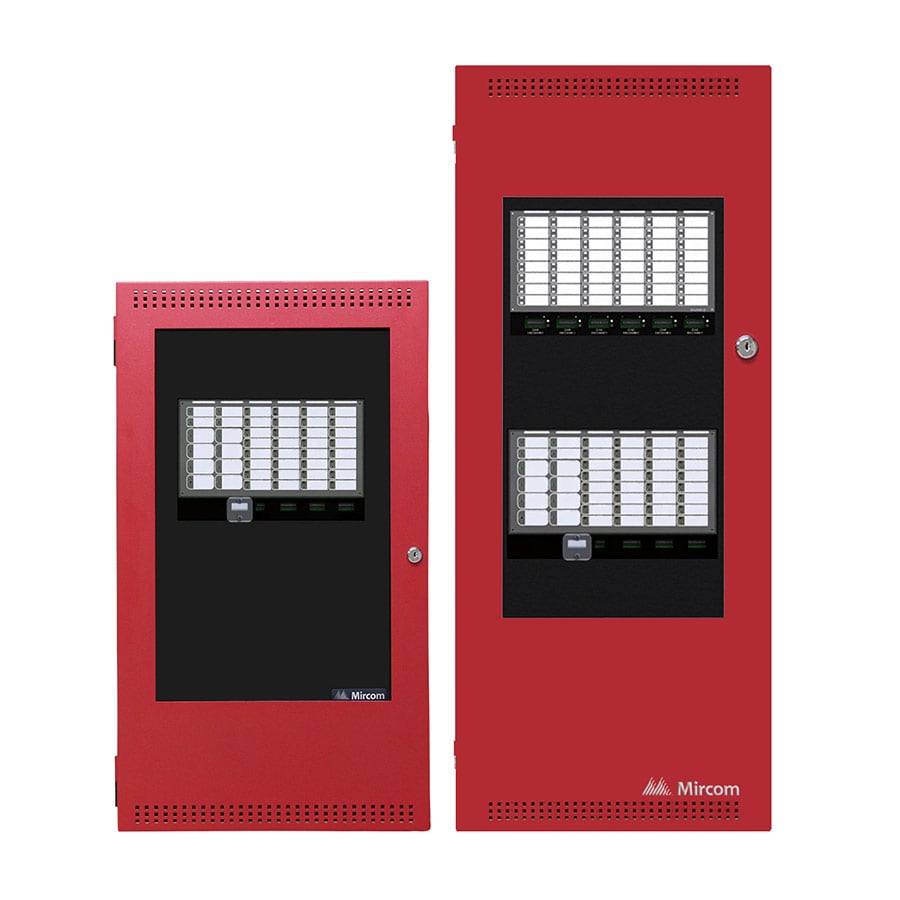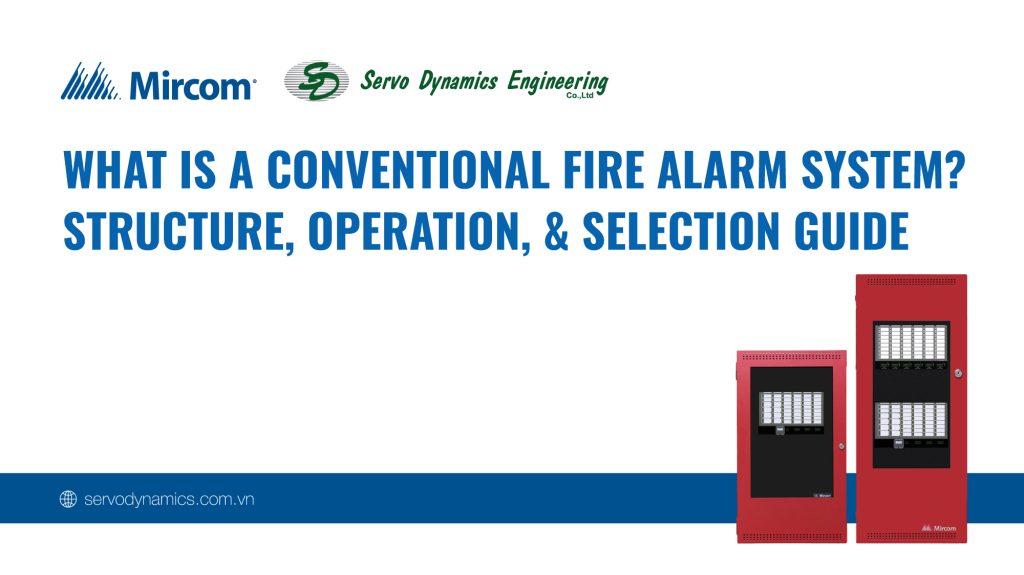Consulting, Fire & Safety
WHAT IS A CONVENTIONAL FIRE ALARM SYSTEM? STRUCTURE, OPERATION, & SELECTION GUIDE
What is the backbone of fire safety in countless small, simple facilities? It is a conventional fire alarm system. This time-tested technology provides a simple, reliable, and cost-effective method for detecting fires and alerting occupants.
What is a Conventional Fire Alarm System?
Definition of a Conventional Fire Alarm System
A conventional fire alarm system is a traditional fire detection architecture that divides the entire protected area into large, separate sections called zones.
Imagine it as a neighborhood watch network: All detection devices (smoke detectors, heat detectors, and manual call points) within a specific zone are wired in parallel on the same circuit and connected back to the Fire Alarm Control Panel (FACP).
When an event occurs (smoke or rising temperature), the device activates the circuit, causing the control panel to display an alarm at the corresponding zone number.
Advantages and Limitations of a Conventional Fire Alarm System
Choosing a fire safety system requires weighing its advantages against its limitations:
| Feature | Advantage | Limitation |
| Cost | Budget-Friendly (Equipment and control panels are significantly cheaper than addressable systems). | Higher Wiring Density (Each zone requires a separate circuit, which can become complex with many zones). |
| Installation & Maintenance | Simple and Easy to install in basic floor plans. | Vague Location Information (Only indicates the zone, not the exact device, slowing down response time). |
| Reliability | Proven Reliability (Industry standard for decades). | Time-Consuming Troubleshooting (Requires manual inspection of every device in the zone to pinpoint a fault). |
Structure and Components of a Conventional Fire Alarm System
A basic conventional fire alarm system consists of the following 5 main components:
| Device | Primary Function |
| 1. Fire Alarm Control Panel (FACP) | The brain of the system. Receives and processes signals from detectors and issues alarm commands. |
| 2. Various Fire Detectors | Sensing devices (smoke, heat, flame) are responsible for detecting the initial fire incident. |
| 3. Manual Call Point | A device used to trigger an alarm when a person detects a fire manually. |
| 4. Notification Devices | Sounders and Strobes (horns and flashing lights) to emit audible and visual warning signals. |
| 5. Signal and Power Cables | Connects devices to the control panel and supplies operating power. |
Basic Conventional Fire Alarm System Installation Model Diagram
The conventional fire alarm system uses a radial wiring diagram:
- Control Panel (FACP): Serves as the central point.
- Initiating Device Circuit (IDC): Each zone is connected to the FACP via a separate circuit. Detectors and manual call points within the same zone are wired in parallel and connect to this circuit.
- End-of-Line Resistor (EOL): Must be installed at the end of every IDC circuit so the control panel can monitor the circuit status (normal, alarm, open circuit fault).
Applications of Conventional Fire Alarm Systems
Due to its simplicity and zone-based location capability, the conventional fire alarm system is perfectly suited for facilities with simple layouts, small to medium sizes, where visual inspection is easy.
- Residential Homes/Large Villas: Ensures basic safety with optimal cost.
- Small Offices & Startups: Low initial cost, a budget-friendly safety solution.
- Retail Stores/Pharmacies: Compact spaces with clear visibility.
- Small Workshops and Warehouses/Small Server Rooms: Open layouts facilitate easier visual identification of the alarm source.
Operating Principle of a Conventional Fire Alarm System
The core of the system lies in its zoning structure and the ability of the circuit to change its electrical state.
The operating process occurs in 3 main phases:
Phase 1: Monitoring (Normal State)
- The FACP continuously supplies a small current (supervisory current) through the IDC circuits.
- This current is measured at the End-of-Line Resistor (EOLR), confirming that the circuit is intact and has no faults (e.g., open circuit or short circuit).
Phase 2: Detection and Alarm (Alarm State)
- When an event occurs (smoke entering a detector or a manual call point being activated), the impedance of that device changes suddenly (or switches to a short-circuit state).
- This causes the current flowing in that zone’s IDC circuit to increase to the Alarm Current level.
- The FACP detects this current increase, identifying it as a fire alarm event.
Phase 3: Response
- The FACP immediately displays the zone number where the incident is occurring on the screen.
- The FACP activates the separate Notification Appliance Circuit (NAC), triggering the facility’s horns and strobes.
- The FACP activates relays to control peripheral devices, such as shutting down elevators, opening/closing exit doors, or transmitting signals to the fire department.
Schematic Diagram Illustration
In the block diagram of a conventional fire alarm system:
- The IDC circuit for Zone 1 runs from the FACP, through all detectors in Zone 1, and terminates with an EOLR.
- The IDC circuit for Zone 2 (or N) is similar and independent of Zone 1.
- The NAC circuit runs from the FACP through the horns and strobes, and also terminates with an EOLR.
All detection circuits are independent and wired radially back to the control panel.
Conventional vs. Addressable Fire Alarm System Comparison
The decision between the two systems is crucial and should be based on the size, complexity, and safety priorities of the building.
Operating Principle of an Addressable Fire Alarm System
The Addressable Fire Alarm System uses a digital communication protocol.
- Devices are connected to a single loop wiring circuit.
- Every device (detector, call point) has a unique ID address (e.g., Address 10, 11, 12…).
- The control panel constantly communicates with each device. When an alarm occurs, the panel knows the precise device and its specific location (e.g., “Smoke detector at Server Room, 3rd Floor”).
Comparison of Conventional and Addressable Fire Alarm Systems
| Feature | Conventional Fire Alarm System | Addressable Fire Alarm System |
| Detection Accuracy | Only identifies alarms by zone. | Identifies alarms by individual device and exact location. |
| Wiring System | Requires separate wiring for each zone (Radial Wiring). | Uses single loop wiring, saving on cable. |
| Initial Cost | Lower for small-scale installations. | Higher due to advanced technology and required programming. |
| Maintenance & Troubleshooting | Requires manual fault checking, which is time-consuming. | Self-diagnoses faults (e.g., dirty detector) and reports location, making maintenance faster and more efficient. |
| Scalability | Adding zones often requires significant rewiring. | Easy to add or reprogram devices without major infrastructure changes. |
Selecting the Right Fire Alarm System Based on Project Scale
- Choose Conventional:
- Small projects with a tight budget (such as stores, 1-2 story offices).
- Simple layout, easy to visually inspect and access.
- Low number of zones required.
- Choose Addressable:
- Large, complex projects (such as high-rise buildings, hospitals, hotels, shopping centers).
- Requires fast response time and precise location identification for effective evacuation and firefighting.
- Requires integration with Building Management Systems (BMS).
Common Faults in Conventional Fire Alarm Systems
Faults (Trouble Signals) in conventional systems are generally simple but must be fixed quickly to ensure the system remains functional.
| Common Fault | Description and Cause | Troubleshooting and Maintenance |
| Open Circuit Fault | Trouble signal due to a broken signal cable (IDC or NAC), or a detector/device being removed. | Check the integrity of the wiring circuit, especially at connection points and the End-of-Line Resistor (EOLR). |
| Dirty Detector Fault | Smoke detector accumulating excessive dust, reducing sensitivity, or causing false alarms. | Periodic maintenance by cleaning and vacuuming the detectors using specialized compressed air. |
| Weak Battery Fault | Backup power (battery) is worn out, damaged, or the voltage drops below the specified level. | Check the battery lifespan (typically 2-3 years), and replace it with a new battery. Ensure a stable main power supply. |
| Earth Fault | The signal or power cable is touching the metal casing or the building’s ground structure. | Check and isolate the location of the earth fault using specialized measuring devices. |
| Control Panel Fault | Usually a hardware failure or a blown fuse. | Contact a professional technical team to inspect, repair, or replace the panel components. |
Periodic maintenance not only ensures system stability but is also a mandatory requirement to comply with current Fire Prevention and Fighting (PCCC) regulations. The fire alarm system must be inspected and accepted according to Vietnamese standards.
Real-World Applications of Conventional Fire Alarm Systems
The conventional fire alarm system is an optimal solution for:
- Residential Projects: Individual residences, boarding houses, townhouses with floor areas under 500m², and simple structures.
- Industrial & Commercial Projects:
- Small-scale parking basements.
- Small manufacturing workshops with few highly flammable areas.
- Kindergartens, clinics, and small retail stores in simple zones.
Reputable Conventional Fire Alarm System Brands
Selecting quality equipment from world-leading brands is a key factor in ensuring system reliability. Prominent brands in the Vietnamese market include:
- Mircom (Canada): A leading global life safety corporation, known for its advanced conventional and addressable fire alarm products with flexible features.
- Notifier – Honeywell (USA): A premium brand offering comprehensive safety solutions, from conventional fire alarms to large integrated systems.
- Hochiki (Japan): Famous for its durability and high reliability, a popular choice in many constructions in Vietnam.
- Unipos (Europe): Provides fire alarm solutions with modern technology, meeting strict EU standards.

The Mircom Conventional Fire Alarm System
Not all conventional fire alarm systems are created equal. The Mircom FA-1000 Series is a prime example of applying modern microprocessing to enhance the performance of a conventional system.
The Mircom FA-1000 Series offers powerful features designed to maximize flexibility and ease of operation, going beyond basic zoning:
- Flexibility & Customization: The control panel can be fully configured for single-stage or two-stage operation easily via DIP switches.
- Modular Capacity: The system is modularly designed, allowing easy expansion by installing add-on modules for more Initiating Circuits (zones) or Notification Appliance Circuits (horns/strobes).
- Easy Maintenance: Includes a One-Man Walk Test function, simplifying and speeding up periodic maintenance.
The FA-1000 Series proves that a conventional fire alarm system can still be a highly reliable and flexible solution, especially for projects prioritizing cost-effectiveness and customization.
Authorized Distributor of Mircom Conventional Fire Alarm Systems in Vietnam – Servo Dynamics
The choice of system (Conventional or Addressable) requires careful consultation. However, regardless of the choice, equipment quality and support service are always the most critical factors.
To ensure your fire alarm system meets the highest standards and operates reliably, it is essential to select products from globally reputable manufacturers like Mircom.
Servo Dynamics Engineering is proud to be the Official Authorized Distributor of Mircom fire alarm and life safety equipment in Vietnam.
We provide a full range of products, including the advanced FA-1000 Series Conventional Fire Alarm Control Panels. By partnering with us, you benefit from:
- Genuine Products: Guaranteed quality, reliability, and compliance with international standards.
- Expert Technical Support: Our team of experts is ready to consult, install, and maintain the system for your project.
- Optimal Investment Value: Helping you implement cost-effective Conventional Fire Alarm Systems without compromising safety.
Contact Servo Dynamics Engineering today for consultation on the most suitable Conventional Fire Alarm System solution for your facility!

 Tiếng Việt
Tiếng Việt



